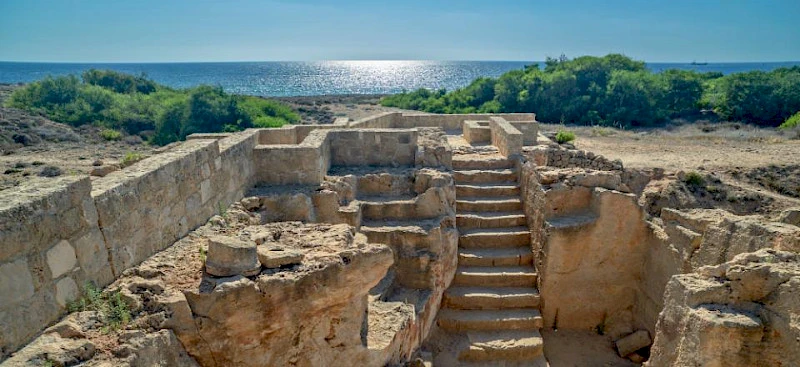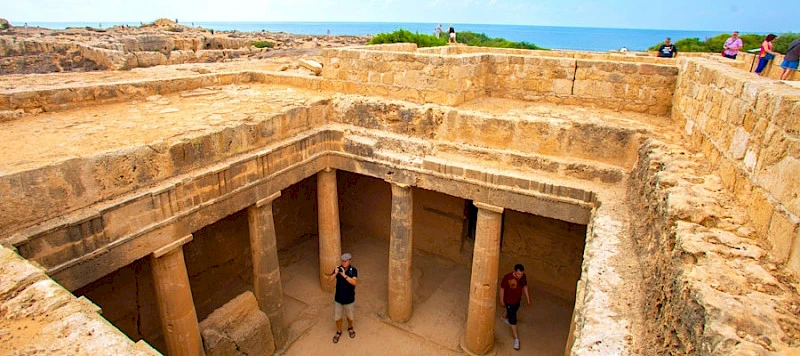The Royal Tombs of Cyprus
One of the most important historical landmarks not only of Paphos but of all Cyprus. The history of the place and useful information for tourists — in our article.
By the way, these tombs are not related to kings, but there is no doubt that they are tombs. They are part of the Paphos Archaeological Park (located about one and a half kilometers to the south) and, together with it, are included in the UNESCO World Heritage List.
- What the Royal Tombs are like
- History of the Royal Tombs in Cyprus
- When to visit
- How to find the Royal Tombs
- Other frequently asked questions

The Royal Tombs: General Information
These monumental underground tombs are carved from solid rock and date back to the Hellenistic and Roman periods.
These were not royal burials, but rather those of high-ranking officials and aristocrats. However, the size and grandeur of the tombs — some of which are decorated with Doric columns — gave the area its majestic name.
Some tombs resemble residential houses: the burial chambers open into what appears to be a guest hall. They are similar to tombs found in Alexandria, indicating close connections between the two cities during the Hellenistic period.
The significance of the tombs lies in the habit of the Paphites to include Rhodian amphorae as offerings in the burials. Thanks to the production stamps on the handles of these amphorae, their date can be determined, along with other materials from the same burial.

History of the Royal Tombs in Paphos
Many of the underground tombs carved from solid rock date back to the 4th century BC, and it is believed that it was during this time that the Paphos aristocrats and high-ranking officials began to be buried here. This continued until the 3rd century AD. However, there are few historical facts preserved, and in general, not much is known beyond this.
The tombs have been explored for centuries, but the actual research has been limited. The earliest modern description was written by Richard Pococke in 1783. Almost a century later, in 1870, the first archaeological excavations were carried out by Luigi Palma di Cesnola, the American consul in Cyprus of Italian origin. He is believed to have taken most of the relics from the island and sold them to the Metropolitan Museum in New York.
In 1915, the first excavations took place under the scientific supervision of Menelaos Markides, curator of the Cyprus Museum. Systematic excavations were carried out in the late 1970s and 1980s under the leadership of Dr. Sophocles Hadjisavvas, former director of the Cyprus Department of Antiquities.
Unfortunately, much of the information related to the tombs has been lost over time. It is believed that many of the tombs were rich in valuable burial items and were likely plundered, including before the amateur excavations of Cesnola — because official archaeological missions found very few such items. Furthermore, the proximity of the tombs to the sea hindered the preservation of the buried bodies.

When is the best time to visit the Royal Tombs in Cyprus?
It is considered best to visit in the spring — at the end of March and April, when it is not too hot, and you can see greenery around. A refreshing breeze blows from the sea at this time.
It is not recommended to visit the tombs in July and August, during the peak heat — there is little shade near the attraction.
Official working hours of the Royal Tombs:
- April 16 — September 15, daily: 08:30 — 19:30
- September 16 — April 15, daily: 08:30 — 17:00
The attraction is open year-round but is closed on Christmas, New Year, and Easter Sunday.
How to find the Royal Tombs in Cyprus and how to get there
It is located in the eastern part of the city, on the seashore. The location on the map of the tomb entrance is below the text.
Public transport does not stop directly at the entrance, but the nearest stop is 200 meters to the south. Bus number 615 runs from the city center to this stop, which is also called "Tombs of the Kings." It is recommended to tell the driver in advance to stop, as it is often missed.
You can also take a taxi or rent a car, which is easy and inexpensive to do in Cyprus — starting from 10 euros per day (via Localrent or Discover Cars).
There is free parking right in front of the entrance to the site.
Frequently Asked Questions about the Royal Tombs in Cyprus
How much is the entrance fee to the Royal Tombs?
The entrance fee to the tombs is €2.50 per person. Children under 4 years old can visit the site for free. For organized groups of more than 10 people, the ticket price is reduced by 20%. You can also purchase a Cyprus attractions pass.
Is there a toilet at the Royal Tombs in Cyprus?
Yes, but it is not on the necropolis grounds, rather near the entrance, not far from the parking lot. It is free to use.
Is the Royal Tombs site accessible for disabled visitors?
The archaeological park is partially wheelchair accessible, but only from above — it is not possible to descend into the tombs. Caution is needed as it is easy to fall into various crevices, so it is better not to approach closely with a wheelchair and to keep an eye on children.
Is there a café at the Royal Tombs in Cyprus?
No, there are no food stands at the site, nor any kiosks with snacks or even water. It is better to bring something with you, and especially in the summer, don’t forget to take water!
Follow us on Instagram and Telegram — we share a lot of interesting information about attractions in Cyprus!
